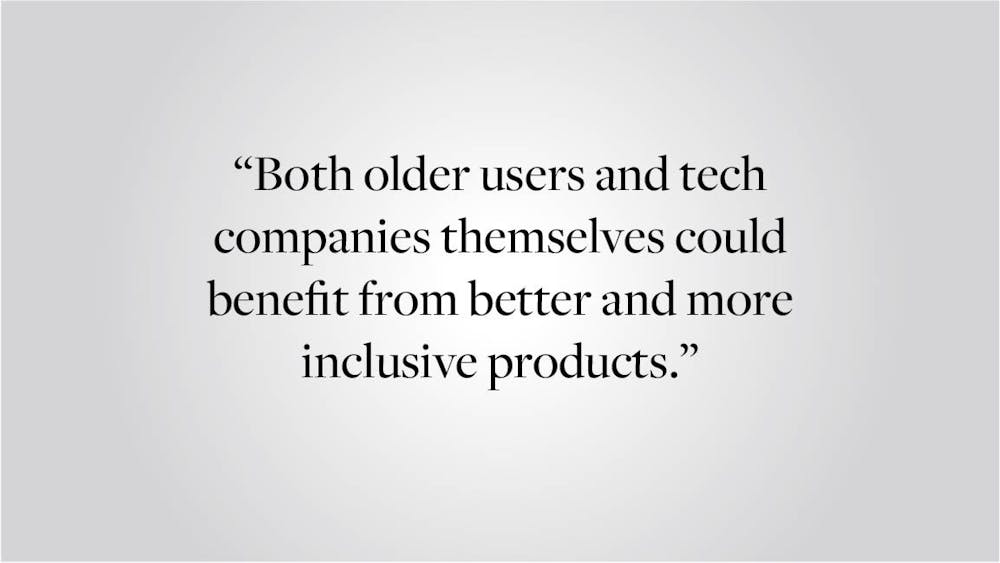A few years ago, I saw one of my grandfather’s friends copying an email into a Microsoft Word document word-by-word so that he was re-pasting the entire body of text. I curiously asked what he was doing, and he said that he needed to print out the email so he was painstakingly transferring it over to Word. Not only had he been unaware that you can use the Command-P keyboard shortcut to print out any webpage or document, but he hadn’t even known there was a way to copy and paste the entire text from his email into a different place.
Frankly, I was shocked. I can’t pinpoint how I personally know all of these shortcuts. My generation — known for being tech savvy — seems to have some sort of intuition for learning new internet technologies. I can’t remember the last time I had to get someone to proactively help or teach me how to use a website: A bit of experimentation on the page or a quick Google search usually suffices. By contrast, the older people in my life seem to rely on younger people for clear step-by-step explanations of how to use basic internet-based services like Amazon or Twitter. Some see this disparity as a praiseworthy aptitude for tech on the part of young people, but the reality is that tech is largely ageist. Internet technologies are made exclusively for the younger generations and disregard older generations' needs — but it doesn't have to be this way.
Older generations face a disproportionate amount of confusion when using internet-based services for a variety of reasons, but not necessarily the ones most people think. It isn’t that older people don’t want to embrace the internet or use it regularly — over half of all adults over 65 in the United States use the internet, and of those who do, 701% say they use it on an average every day or almost every day, according to polling from the Pew Research Center. Even so, 77% of adults in the same age group say they require direct assistance from others when learning how to use new digital technologies, presumably because they feel too incapable to do so themselves.
One major reason why older generations may feel this way could be that the technologies they are trying to adopt are designed with young people in mind. One study found that the two of the biggest unique issues that older people face when trying to use the internet are their unfamiliarity with understood internet conventions and physical or health challenges. User interface conventions like icons for search, settings or notifications can become points of visual confusion when the user doesn’t recognize what they signify. Meanwhile, issues like poor vision or lack of dexterity can seriously inhibit how easily people can use electronic devices.
These challenges can be extremely frustrating when attempting to use the internet. My own parents sometimes even struggle with navigating all the icons that crowd the interfaces of websites like Amazon and Facebook. For them, forgetting what any one of these symbols represents can turn into wasted time clicking through the same pages, unable to find the information they need or complete the task they intended to. This kind of experience can seriously discourage older people from relying on or even occasionally using internet-based services.
Many modern devices are enabled with “night shift” or “blue light” views, which adjust screen colors to reduce strain on the eyes, and other accessibility features that improve user experience. But there is no mandate for web publishers to abide by recommended accessibility standards. This means it’s very common to encounter web pages that fail to meet these standards, many rife with design flaws like low contrast color schemes or poorly documented iconography. While these characteristics may not prevent web pages from feeling intuitive for the average user, this “average user” is often assumed to be relatively young. As such, older people, who may prefer high contrast displays and easy zoom options over more nuanced aesthetics, often aren’t able to benefit from current design conventions for user interfaces. This inaccessibility leads them to become overly dependent on younger generations for technological help.
In fact, this issue tends to get swept under the rug because of older age groups’ glaring lack of involvement in the tech industry. The software development industry is known for ageism in hiring, with a major skew towards new graduates and other younger candidates. For the same reasons we value diversity in other realms (race, gender, sexuality, etc.), we should recognize the benefits of the contributions of software engineers from different age groups. If even just a bit more weight were given to the preferences and needs of older people during development of mainstream software, both older users and tech companies themselves could benefit from better and more inclusive products.
In order for emerging technologies to become accessible to all age demographics, it’s imperative that the input of older people is incorporated during development. Without listening to these valuable voices, we risk permanently excluding them from technological developments. While we all have different ideas about to what extent technology should meet the needs of diversefferent communities, I doubt anyone would think of my grandfather’s friend’s experience trying to print an email as a success story. At the end of the day, good technology should work for everyone. If it can’t be adapted and improved for this purpose, it simply isn’t good technology. Similarly, if our design processes are failing to be inclusive, it is time to change them.
Anika Bahl ’24 can be reached at anika_bahl@brown.edu. Please send responses to this opinion to letters@browndailyherald.com and other op-eds to opinions@browndailyherald.com.





